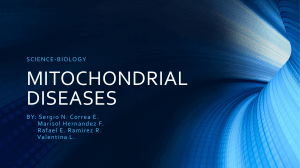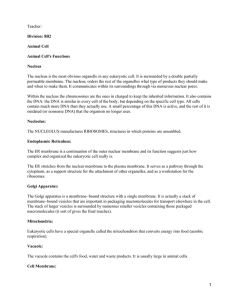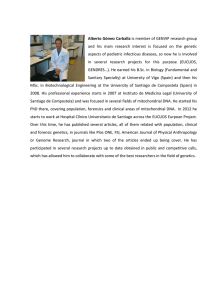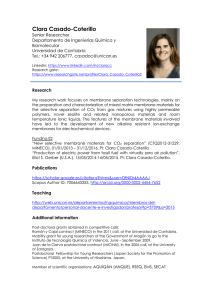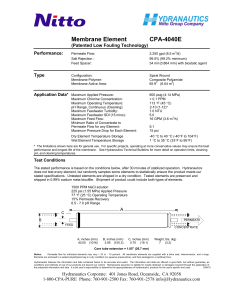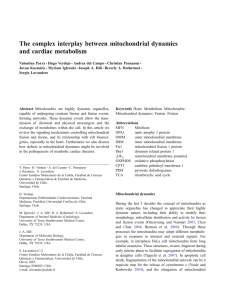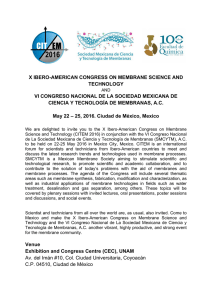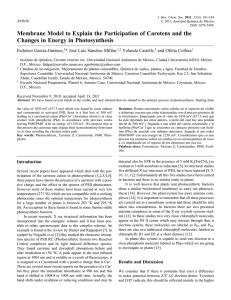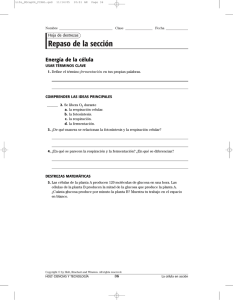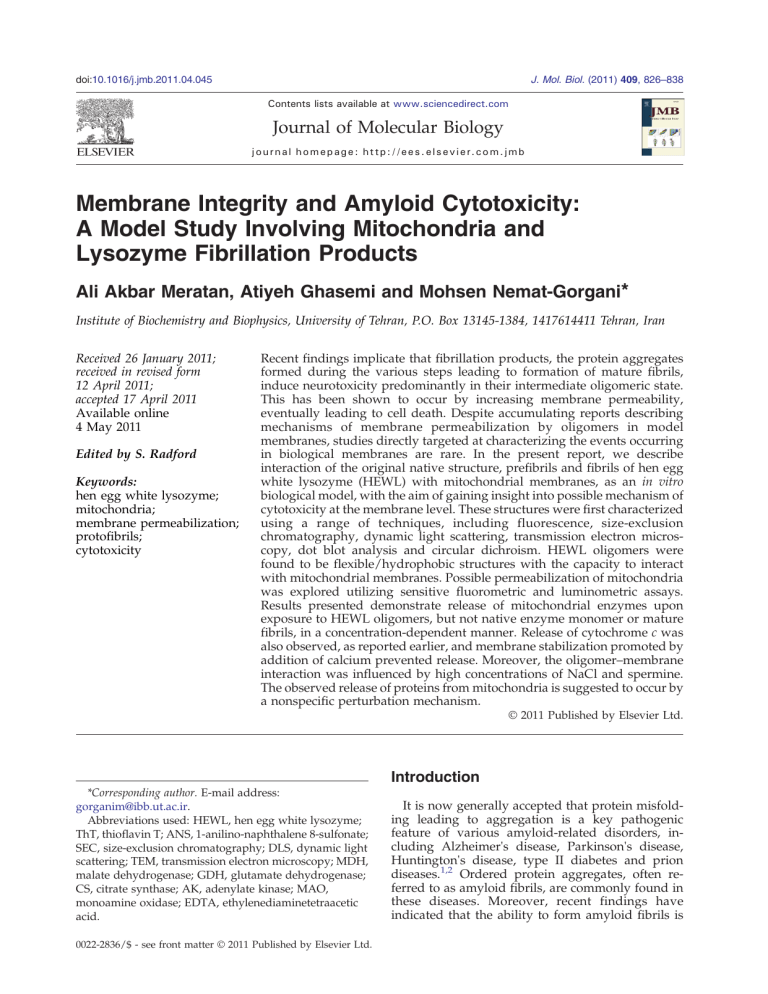
doi:10.1016/j.jmb.2011.04.045 J. Mol. Biol. (2011) 409, 826–838 Contents lists available at www.sciencedirect.com Journal of Molecular Biology j o u r n a l h o m e p a g e : h t t p : / / e e s . e l s e v i e r. c o m . j m b Membrane Integrity and Amyloid Cytotoxicity: A Model Study Involving Mitochondria and Lysozyme Fibrillation Products Ali Akbar Meratan, Atiyeh Ghasemi and Mohsen Nemat-Gorgani⁎ Institute of Biochemistry and Biophysics, University of Tehran, P.O. Box 13145-1384, 1417614411 Tehran, Iran Received 26 January 2011; received in revised form 12 April 2011; accepted 17 April 2011 Available online 4 May 2011 Edited by S. Radford Keywords: hen egg white lysozyme; mitochondria; membrane permeabilization; protofibrils; cytotoxicity Recent findings implicate that fibrillation products, the protein aggregates formed during the various steps leading to formation of mature fibrils, induce neurotoxicity predominantly in their intermediate oligomeric state. This has been shown to occur by increasing membrane permeability, eventually leading to cell death. Despite accumulating reports describing mechanisms of membrane permeabilization by oligomers in model membranes, studies directly targeted at characterizing the events occurring in biological membranes are rare. In the present report, we describe interaction of the original native structure, prefibrils and fibrils of hen egg white lysozyme (HEWL) with mitochondrial membranes, as an in vitro biological model, with the aim of gaining insight into possible mechanism of cytotoxicity at the membrane level. These structures were first characterized using a range of techniques, including fluorescence, size-exclusion chromatography, dynamic light scattering, transmission electron microscopy, dot blot analysis and circular dichroism. HEWL oligomers were found to be flexible/hydrophobic structures with the capacity to interact with mitochondrial membranes. Possible permeabilization of mitochondria was explored utilizing sensitive fluorometric and luminometric assays. Results presented demonstrate release of mitochondrial enzymes upon exposure to HEWL oligomers, but not native enzyme monomer or mature fibrils, in a concentration-dependent manner. Release of cytochrome c was also observed, as reported earlier, and membrane stabilization promoted by addition of calcium prevented release. Moreover, the oligomer–membrane interaction was influenced by high concentrations of NaCl and spermine. The observed release of proteins from mitochondria is suggested to occur by a nonspecific perturbation mechanism. © 2011 Published by Elsevier Ltd. Introduction *Corresponding author. E-mail address: [email protected]. Abbreviations used: HEWL, hen egg white lysozyme; ThT, thioflavin T; ANS, 1-anilino-naphthalene 8-sulfonate; SEC, size-exclusion chromatography; DLS, dynamic light scattering; TEM, transmission electron microscopy; MDH, malate dehydrogenase; GDH, glutamate dehydrogenase; CS, citrate synthase; AK, adenylate kinase; MAO, monoamine oxidase; EDTA, ethylenediaminetetraacetic acid. 0022-2836/$ - see front matter © 2011 Published by Elsevier Ltd. It is now generally accepted that protein misfolding leading to aggregation is a key pathogenic feature of various amyloid-related disorders, including Alzheimer's disease, Parkinson's disease, Huntington's disease, type II diabetes and prion diseases.1,2 Ordered protein aggregates, often referred to as amyloid fibrils, are commonly found in these diseases. Moreover, recent findings have indicated that the ability to form amyloid fibrils is 827 Membrane Integrity and Amyloid Cytotoxicity a generic property of all proteins rather than a characteristic feature of only those associated with pathological conditions.1–5 Formation of amyloid fibrils by various proteins and polypeptides precedes by the occurrence of metastable, partially folded oligomeric intermediates often referred to as protofibrils, 6–8 which have been found to be cytotoxic.2,9–12 Moreover, the toxic activity of prefibrillar oligomers may be due to the fact that they share a common structure, suggesting that they may also share a common mechanism of toxicity.13 The fact that different amyloids arise from either the cytosolic or the extracellular protein points to the plasma membrane as a potential primary target that is accessible to both compartments.2,11,14,15 Although there appears to be a consensus on membrane permeabilization by amyloid oligomers, it is disputed whether this is due to the discrete channel formation or to a nonspecific perturbation of bilayer integrity, since evidence for both possibilities has been obtained. 14–20 In addition to plasma membrane as a primary target, internal organelles, such as mitochondria, may also be affected.21 Recent reports indicate that mitochondrial dysfunction may play a critical role in the development of neurodegeneration in a number of pathological conditions.22,23 Accumulation of β-peptide and αsynuclein has been shown to occur with predominant localization in the inner-membrane structures.24,25 Of the various consequential events, cell death is often attributed to an increase in mitochondrial membrane permeability.26,27 Lysozyme, more specifically hen egg white lysozyme (HEWL), is one of the most extensively studied proteins whose structure and physiochemical properties have been well characterized.28 With a high pI of 11,29 the protein bears a net positive charge over a broad pH range and has a high affinity for anionic and neutral phospholipids, both at low and high ionic strengths.30 In addition to its lipid-binding properties, it was found to induce release of the aqueous contents of uncharged vesicles, presumably as a result of its insertion into the lipid bilayer, causing disruption.30,31 HEWL has been shown to abundantly form well-defined amyloid fibrils under in vitro conditions, making it an ideal model for the study of amyloid aggregation.32 Additionally, it is homologous to human lysozyme, the variants of which have been shown to form amyloid fibrils, implicated in hereditary systemic amyloidosis.33 Although a large body of evidence suggests membrane perturbation as a primary mechanism of toxicity in neurodegenerative diseases, most of such conclusions have been based on studies involving phospholipid model systems. In the present study, mitochondria isolated from rat brain were used as an in vitro model to examine the possible destructive effects of HEWL oligomers and fibrils. It is proposed that the organelle with its well- characterized membranes consisting of various biologically active components, combined with its exceptional biochemical composition and compartmental diversity, may provide an extremely useful model system for biophysical studies related to mechanism of cytotoxicity at the membrane level, leading to cell death. Results and Discussion Membrane disruption by amyloid oligomers is often considered as a primary mechanism of toxicity in neurodegenerative disorders, but the mechanism by which these structures eventually cause cell dysfunction and death is not clearly understood. One of the problems associated with these investigations is related to the fact that the oligomeric species are often unstable, making detailed structural analyses difficult.34 It is generally believed that enhancement of hydrophobicity initiated by protein misfolding provides these structures with the ability to interact with membranes, resulting in loss of membrane integrity and thereby cytotoxicity.9,35–38 Furthermore, such hydrophobicity-based toxicity mechanism has been shown to be shared by bacterial toxins and viral proteins.39 In addition to hydrophobic interactions, electrostatic forces involving charged residues in protein structures and charged or polar lipid molecules have been concluded to provide the second major interactions in the association process.40 Two mechanisms of membrane disruption have been recently proposed. The first argues that membrane permeabilization is induced by formation of specific, discrete ion channels that may be inhibited by specific channel blockers,18–20 and the second suggests involvement of a nonspecific mechanism of membrane perturbation in the absence of unitary conductance.14–17 HEWL is one of the best-characterized proteins whose amyloidogenesis, in particular, has been extensively studied under in vitro conditions.32,41–43 In the present study, interaction of HEWL oligomers and fibrils on mitochondrial membranes was investigated. Oligomeric and not fibrillar structures have been found to have the capacity to cause release of mitochondrial enzymes. Oligomer characterization The structural and morphological features of HEWL oligomers have been investigated by employment of a range of techniques, including fluorescence [(thioflavin T (ThT), 1-anilino-naphthalene 8-sulfonate (ANS) and acrylamide quenching)], size-exclusion chromatography (SEC), dynamic light scattering (DLS), transmission electron microscopy (TEM), circular dichroism (CD) and dot blot 828 analysis. ThT, a fluorescent dye specific for amyloid structures, was used for monitoring the kinetics of HEWL fibril formation. The experimental data points fit well to a sigmoidal curve, indicating the presence of an initial lag phase of about 5 days, followed by a growth phase that reaches a plateau at about 12 days of incubation (Fig. 1a). In the course of oligomer formation (Fig. 1b), hydrophobic sites became increasingly exposed, as monitored by binding of ANS, leading to fluorescence enhancement, with a pronounced blue shift of the spectrum from 528 nm to 485 nm (Fig. 1b). Further incubation resulted in shifting of the spectrum toward shorter wavelengths by not more than 5 nm (data not shown). Structural flexibility was determined by dynamic quenching experiments, using acrylamide as a neutral fluorescence quencher. A significant enhancement in the Stern–Volmer constant was observed at 5 days of incubation (Fig. 1b), suggesting an increase in flexibility upon oligomer formation. Continuation of the fibrillation process coincided with a decrease in flexibility/more com- Membrane Integrity and Amyloid Cytotoxicity pact structure (Fig. 1b). The amount and molecular mass of the oligomeric species formed upon 5 days of incubation were determined as presented in Fig. 2a, where two peaks corresponding to prefibrillar oligomeric species (14 min , consisting of about 15% of total protein) and monomer (24 min) are evident. The void peak containing HEWL oligomers appeared slightly after thyroglobulin (670 kDa), used as one of the molecular mass standards, suggesting an average molecular mass of about 600 kDa (N 40 monomers). The actual mass of these prefibrillar species could be smaller than what appears.44 Particle dimensions and distributions of HEWL monomer and oligomers were extracted from DLS experiments. Both DLS runs and TEM images indicated formation of two main oligomeric species (Fig. 2b and c). However, only one peak corresponding to larger oligomeric structures was suggested by the SEC chromatograms, presumably due to the more transient nature of the smaller aggregates.45 Upon 15 days of incubation, welldefined mature fibrils with typical amyloid morphology were formed, with no oligomer being visible (Fig. 2c). Moreover, formation of HEWL oligomers was found to take place well before any marked increase in ThT fluorescence (Fig. 1a), with transition from the predominantly α-helical structure in lysozyme monomers to a partially unfolded form (Fig. 2d). Our results suggest that structural flexibility and exposure of hydrophobic surfaces are two remarkable characteristics of HEWL oligomers, indicating a major conformational rearrangement in the protein structure upon incubation under the denaturing conditions employed, eventually leading to fibril formation. Furthermore, the A11 antibody that is frequently used for recognition of the conformational epitopes specific for oligomeric aggregates binds to the HEWL oligomers, initiated from polypeptides of diverse primary structures (Fig. 2e).13 Release of mitochondrial enzymes upon interaction with HEWL fibrillation products Fig. 1. HEWL amyloid fibrillation upon incubation at 1 mM concentration in 50 mM glycine buffer (pH 2.2) at 57 °C. (a) Kinetics of amyloid formation as monitored by ThT fluorescence. (b) Size distribution upon oligomerization (□) and ANS binding (■) are indicated on the left-hand y-axis, and changes in the Stern–Volmer constant with time of incubation (○) are indicated on the right-hand y-axis. ANS fluorescence at 12 days of incubation is also indicated as one single point. The inset shows Stern–Volmer plots at different times of incubation of the native monomer: zero time (●), day 3 (○), day 5 (□) and day 7 (■). Mitochondrial membrane permeabilization was characterized using sensitive fluorometric and luminometric assays. Initial experiments suggested that the oligomeric species formed upon 5 days of incubation of HEWL under the denaturing conditions were very effective in causing substantial release of mitochondrial enzymes. This was not unexpected since earlier results indicated that the oligomers were both flexible and hydrophobic (Fig. 1b) and, therefore, of favorable characteristics for efficient interaction with a phospholipid bilayer. Release of malate dehydrogenase (MDH) occurred via a fast phase (b 3 min) followed by a slower increase, reaching a maximum value in about 10 min of treatment (Fig. 3a, inset). Interaction of HEWL Membrane Integrity and Amyloid Cytotoxicity 829 Fig. 2. Structural and morphological characterization of HEWL oligomers. (a) Gel-filtration chromatogram upon incubation for 5 days, showing two distinguished peaks corresponding to prefibrillar oligomers and monomers. The arrows indicate elution volumes of the standards [thyroglobulin, 670 kDa (1); γ-globulin, 158 kDa (2); ovalbumin, 44 kDa (3); myoglobin, 17 kDa (4); and vitamin B12, 1.35 kDa (5)]. (b) Hydrodynamic radii of the HEWL oligomers as estimated by DLS. Two oligomeric species with sizes of 46 nm and 180 nm and the original monomeric protein are indicated. (c) TEM images of oligomers upon 5 days of incubation and fibrils (after 15 days). (d) Far-UV CD spectra of HEWL corresponding to monomer (●), 5-day-old oligomers (■) and 15-day-old fibrils (▲). (e) Recognition of HEWL oligomers by the A11 antibody: HEWL monomers, oligomers and fibrils were spotted on a nitrocellulose membrane and probed with the oligomer-specific antibody A11. The antibody showed binding only to the oligomers. monomer, oligomer and fibrils with mitochondrial membranes was then investigated. A number of mitochondrial enzymes located at different compartments including monoamine oxidase (MAO) (embedded in the mitochondrial outer membrane), adenylate kinase (AK) (located in the inter membrane space), citrate synthase (CS), MDH and glutamate dehydrogenase (GDH) (located in the mitochondrial matrix) were examined upon addition of protein structures to mitochondrial suspensions and following the procedure outlined under Materials and Methods. To reduce experimental errors, we carried out all assays at the same time (day, hours) with the same protein samples while correcting for binding of the “soluble” matrix enzymes to membrane structures after disruption of mitochondria (see Materials and Methods for details). Substantial release of all of the enzymes tested was observed upon interaction of the oligomers with mitochondria, except for GDH (Fig. 3a and b), in a concentration-dependant manner (Fig. 4). The increase of oligomer concentration or the incubation time appeared ineffective in causing GDH release (data not shown). While some release was detected related to monomers, fibrils were totally ineffective (Fig. 3a and b). Results were highly reproducible when different batches of the oligomeric species prepared at different times were tested except for MAO (Fig. 3a). Release as low as 10%, up to a maximum of 40%, was obtained (based on activity determination, see Materials and Methods) with different batches of oligomer preparations (see Fig. 3a). These large variations in activity may be due to the fact that MAO is a phospholipid-requiring enzyme,46 and lipid depletion upon release/solubilization may occur to different extents, leading to variations in catalytic activity. These results clearly demonstrate that HEWL oligomers may cause profound destabilization of mitochondria, resulting in its permeabilization. Similar observations were made on release of cytochrome c (Fig. 5), in accord with earlier reports.47,48 It appears that high degrees of flexibility and hydrophobicity commonly reported for oligomeric species38 and confirmed in the present study may provide these structures with the capacity to interact with membranes.49 A growing body of evidence strongly implicates the importance of 830 Membrane Integrity and Amyloid Cytotoxicity Fig. 4. Dependency of enzyme release on oligomer concentration. Releases of MDH (●), CS (■) and MAO (□) are indicated on the left-hand y-axis and that of AK (○) is indicated on the right-hand y-axis. Further details are described in the text. flexible structure. 50,51 Subsequently, loss of the ability to cause permeabilization occurs (Fig. 3a and b), which coincides with loss of the ability to bind to A11 antibody (Fig. 2e). Fig. 3. Mitochondrial enzyme release upon interaction with HEWL monomer, oligomer and fibrils. (a) Release of MDH (white bars), CS (light-gray bars), GDH (black bars) and MAO (dark-gray bars), expressed as percentage of the maximum observed upon treatment with Triton X-100 (0.1%) and (b) AK release expressed relative to buffer. The inset represents rapid release of MDH upon incubation of the protofibrillar structures with mitochondria. The minimum time taken to test for enzyme release following the procedure described in Materials and Methods was 3 min. Additional details are described under Materials and Methods. *, p b 0.05; **, p b 0.01. hydrophobic nature of protein aggregates in their cytotoxicity.35–37 Accordingly, the results presented here may be explained in terms of interaction of some exposed hydrophobic and flexible oligomer components with the corresponding structures in the phospholipid bilayers of mitochondria, thereby inducing membrane disruption leading to release of cytochrome c and other proteins, such as those tested in the present investigation. Furthermore, it is proposed that any condition (such as medium temperature and pH, salt or protein/ligand concentration) that may induce protein–protein interactions leading to formation of (hydrophobic/flexible) aggregate assemblies could potentially be cytotoxic. As fibrils become sufficiently long (∼ 12 days of incubation), lateral fibril–fibril interactions may occur, leading to eventual burial of hydrophobic patches (as indicated here by decrease in ANS fluorescence, see Fig. 1b), in a more compact, less Effect of calcium on enzyme release from mitochondria Divalent cations, including calcium, have been found very effective in causing stabilization of biomembranes. 52–54 The effect of calcium on membrane permeabilization was tested in the present study. As indicated in Fig. 6a, release of MDH and AK from mitochondria was very efficiently prevented when mitochondrial membrane components were provided with the opportunity to interact with this counterion. There are many reports suggesting that divalent ions such as calcium may stabilize biological membranes by surface charge reduction,53,54 thereby protecting them from destructive effects of some viruses and toxins.55 Phospholipid vesicle permeabilization induced by wild-type and mutant forms of protofibrillar α-synuclein has also been shown to be diminished in the presence of calcium.56 The Fig. 5. Release of cytochrome c from mitochondria upon interaction with HEWL fibrillation products. Maximum release by treatment with 0.1% Triton X-100 is also indicated. Details are described under Materials and Methods. 831 Membrane Integrity and Amyloid Cytotoxicity distributed in the inner mitochondrial membrane, being preferentially oriented toward the matrix side.57 Membrane stabilization may also be a consequence of an increase in interaction of the oligomers with negatively charged membrane proteins. Membrane condensation afforded by the presence of calcium could increase the energy required for insertion of the HEWL oligomers into the phospholipid bilayer and/or membrane disruption, thereby reducing permeabilization.56 This observation clearly suggests that factors affecting the natural biophysical properties of cellular membranes, such as its flexibility/fluidity, may influence its permeabilization. A clear mechanism for this observation would undoubtedly require extensive investigations. Effect of salts and polyamines Use of 100 mM or higher concentrations of NaCl appreciably diminished (about 15–20%; data not shown) release. The polyamine spermine was more effective (Fig. 6b), further demonstrating the role of electrostatic forces on interaction of oligomers with mitochondria. In addition to this capacity, spermine was found appreciably more effective than salt, presumably due to its multivalent nature and/or membrane stabilization effect.58 Fig. 6. Effect of calcium (a) and spermine (b) on release of enzymes from mitochondria upon interaction with HEWL oligomers. Mitochondrial suspensions at 1 mg/ml protein concentration were incubated with various concentrations of calcium or spermine on ice for 10 min, followed by the procedure described under Materials and Methods to assay for release of enzymes. Releases of MDH (●) and AK (○) are indicated on the left-hand and on the right-hand y-axes, respectively, in (a), and those of MDH (white bars) and CS (dark-gray bars) are shown in (b). *, p b 0.05; **, p b 0.01. lipid and protein components of membranes repulse one another due to negative electrical charges, resulting in decreasing membrane stability. 54 It appears therefore that, in the presence of a divalent ion such as calcium, charge neutralization may eventually lead to membrane condensation and stabilization, presumably by lowering repulsive interactions.53,54 The possibility for such a mechanism related to the role of calcium in the present study is reinforced by the presence of negatively charged phospholipids (cardiolipin, phosphatidyl serine and phosphatidyl inositol) in mitochondrial membranes.57 Of these, cardiolipin, with a double anionic charge, has a unique role in mitochondria, both structurally and functionally. Moreover, this phospholipid, together with phosphatidyl inositol, is asymmetrically Membrane permeabilization induced by oligomers coincided with significant mitochondrial aggregation The presence of 20 μM oligomeric species induced mitochondrial aggregation as evident by pronounced increases in the 90° light scattering of mitochondrial suspensions (Fig. 7). Incubation with HEWL monomer and fibrils also caused aggregation, but to lower extents (oligomers ≫ monomer N fibril; data not shown). Polyamines and salts were much more effective in preventing aggregation as compared to influencing permeabilization (Fig. 7), suggesting that membrane disruption may occur in the absence of appreciable aggregation. Oligomer-induced mitochondrial membrane permeabilization mechanism Mitochondrial membrane perturbation leading to enzyme release appears to have two major characteristics. First, release is fast (about 90% release in the first few minutes) and independent of mitochondrial molecular masses: HEWL oligomers cause release of mitochondrial proteins of various sizes, ranging from 12 kDa (cytochrome c) to 102 kDa (CS). Second, release of mitochondrial enzymes is never complete, as maximum release (60% of that caused by total disruption by treatment with 0.1% Triton X100; see Fig. 4) is observed at 30 min of incubation 832 Fig. 7. Effect of NaCl (a) and spermine (b) on mitochondrial aggregation induced by HEWL oligomers. Mitochondrial homogenates at a final concentration of 1 mg/ml were incubated with various concentrations of NaCl [0 mM (●), 250 mM (■) and 500 mM (□)] or spermine [0 mM (●), 25 mM (■) and 50 mM (□)] for 10 min on ice followed by addition of HEWL oligomers (20 μM). Light scattering of the final suspensions was then determined by DLS. Light scattering of mitochondrial homogenates in the presence of 500 mM NaCl (▲) or 50 mM spermine (▲) is also indicated as controls. See Materials and Methods for further details. with the oligomers used at 25 μM concentration. Furthermore, prolonged incubation (up to 120 min) with use of higher oligomer concentrations (up to 50 μM) did not increase release (data not shown). Two mechanisms of membrane permeabilization have been suggested to explain the disruptive effects of oligomers upon interaction with phospholipid membranes. The first is described as a nonspecific detergent-like perturbation event, and the second is thought to involve formation of ion channels.14–20 The observations described in the present study are more in line with the former mechanism, which would support a size-independent rapid disruption, while the latter would necessitate a size-selective process. The fast nonselective release of mitochondrial enzymes observed in the present study suggests generation of large defects as confirmed Membrane Integrity and Amyloid Cytotoxicity by leakage of high-molecular-weight mitochondrial enzymes. Several proteins are known to form morphologically compatible ion-channel-like structures in phospholipid vesicles, with inner diameters between 1 nm and 2 nm, which, if occurred in a cell, would destabilize cellular ionic homeostasis and thereby induce cell death.59 Such pores, however, would only allow small molecules and metabolites and not molecules of the sizes observed in the present study. Our results are, therefore, consistent with a major disruption of mitochondrial membrane integrity, caused by large-scale but transient mitochondrial membrane lesions, such as those recently reported.60 Such an incomplete release, as a result of damage of a subpopulation of brain mitochondria, may also be due to heterogeneity of brain mitochondria61,62 and prevention of more extensive damage through binding of the monomeric protein present in the oligomer preparations, similar to the effect of monomeric α-synuclein in suppressing prefibrillar permeabilization of phospholipid vesicles.56 Our own preliminary results indicate that mitochondrial heterogeneity may play an important role in the present investigation, since greater extents of enzyme release were observed in liver mitochondria, known to be less heterogeneous in nature62 (data not shown). Therefore, heterogeneity in susceptibility to disruption, as opposed to transient disruption, may also account for the results. Membrane disruption without a size-selective pore formation is not without precedent. As an example, incomplete and transient permeabilization of large unilamellar vesicles loaded with lowmolecular-weight and high-molecular-weight dextrans induced by rabbit neutrophil defensins may be mentioned.63 If our hypothetical mechanism is correct, the amount of enzyme released would be limited by the diffusion rate of the molecules,63 which is inversely proportional to their size. It is therefore possible that the lack of release of GDH in the present study (see Fig. 3a) is due to its very large size (336 kDa).64 Consequently, our finding here demonstrates that oligomeric HEWL species can cause mitochondrial membrane disruption in a nonspecific detergent-like manner, perhaps through the formation of transient lesions. We believe that several findings presented in this communication are especially noteworthy. First, contrary to our own expectations before embarking on the study, membrane permeabilization was very excessive, allowing for release of large proportions of mitochondrial enzymes. Second, the defects are apparently quite large but probably limited in size, allowing for release of proteins as large as 102 kDa (CS) but not 336 kDa (GDH). Third, release of the matrix enzymes appears to require appreciably greater concentrations of the oligomeric structures, suggesting that the inner 833 Membrane Integrity and Amyloid Cytotoxicity membrane is less susceptible to damage. This may be due to greater rigidity of the inner membrane, differences in lipid/protein compositions or the fact that inner-membrane damage requires the initial disruption of the outer membrane. Fourth, release of the enzymes is never complete, presumably being mainly due to the transient nonequilibrium nature of the defects and/or mitochondrial heterogeneity.61,62 Fifth, as a technical limitation of the present study, the minimum time at which release of enzymes from mitochondria could be determined was 3 min, at which most of the release was observed. However, release could be very fast, probably being initiated immediately after interaction. Sixth, since hydrophobicity and flexibility of lysozyme oligomers were not affected by the presence of calcium (data not shown), it is reasonable to assume that membrane stabilization is the main protective event. Formation of smaller defects could be tested upon oligomer treatment in the presence of calcium by looking for release of small molecules rather than the large protein structures examined in the present study. Finally, interaction of the oligomeric structures with mitochondrial membranes may cause subtle changes in lipid/protein interactions, causing alteration in some important functional properties of many membrane proteins. Such fundamentally important membrane perturbation mechanisms may explain some of the reasons for the occurrence of a large array of events describing mitochondrial dysfunction and the prominent role of mitochondria in the pathogenesis of neurodegenerative disorders. Concluding Remarks The present communication describes a model study for the mechanism of prefibrillar cytotoxicity at the membrane level, demonstrating how the oligomeric and not the fibrillar structures formed in the course of HEWL fibrillation may have the capacity to interact with mitochondria. Hydrophobicity and flexibility of the amphiphilic oligomeric structures appear to provide them with the capacity to interact with the membranes,38,49 causing destabilization and subsequent permeabilization, by a nonspecific detergent-like mechanism. Such damaging behavior may cause large defects in the membranes, with subsequent release of mitochondrial enzymes. To a limited extent, release of the proteins may occur irrespective of their size. The limitation is presumably controlled by the size of the lesions transiently occurring upon membrane destabilization. It is suggested that the mitochondrion, with its two membranes of well-defined protein and phospholipid compositions, biophysical properties and compartmental diversity, may provide an extremely useful model for the study of the mechanism of cytotoxicity at the membrane level. Although suggestions have been made here on possible mechanistic features of oligomeric cytotoxicity, a clear definition of the events leading to membrane damage and cell death would avidly require more detailed structural information on the protofibrillar oligomers and the processes involved, leading to membrane permeabilization. Such endeavors would undoubtedly prove to be of major physiological significance. Materials and Methods Materials HEWL (EC 3.2.1.17), ThT, acetyl coenzyme A and 7fluorobenz-2-oxa-1,3-diazole-4-sulfonamide were purchased from Sigma (St. Louis, MO, USA). D-Luciferin was obtained from Synchem Corp. ANS was purchased from Fluka. All other chemicals were obtained from Merck (Darmstadt, Germany) and were reagent grade. Preparation of HEWL oligomers and fibrillar aggregates Protein solutions (1 mM) were prepared in 50 mM glycine buffer (pH 2.2) (pH adjusted with HCl), and aliquots were incubated at 57 °C for 5 days, as oligomer preparations. The oligomer concentrations are given in terms of the monomer protein concentration throughout the article. Mature HEWL fibrils were prepared by incubating the stock protein solution (1 mM) at 57 °C up to 15 days. Fibril concentration was estimated by centrifugation (40 min, 21,000g) and determination of the protein concentration in the supernatant using an extinction coefficient (ɛ1 mg/ml) of 2.63 at 280 nm,65 subtracting it from the original (1 mM) protein concentration. ThT assay All fluorescence experiments were carried out on a Cary Eclipse VARIAN fluorescence spectrophotometer. For monitoring the growth of HEWL fibrils, we performed ThT fluorescence assays in a mixture of 20 μM protein solutions and 25 μM ThT, with excitation fixed at 440 nm and emission at 482 nm. The excitation and emission slit widths were set at 5 nm and 10 nm, respectively. ANS binding assay Emission spectra of ANS were recorded between 400 nm and 600 nm, using an excitation wavelength of 350 nm. Aliquots of the incubated mixtures were diluted (final concentration of 5 μM) in glycine buffer (50 mM, pH 2.2) containing 100 μM ANS. Excitation and emission slit widths were both set at 5 nm. 834 Fluorescence quenching Fluorescence quenching was analyzed according to the Stern–Volmer relationship (F0/F = 1 + Ksv[Q]), where F0 is the fluorescence in the absence of quencher, F is the fluorescence at molar quencher (acrylamide) concentration [Q] and Ksv is the Stern–Volmer constant obtained from the slope of a plot of F0/F versus [Q].66 The excitation wavelength was 280 nm, and acrylamide concentration ranged from 0 M to 0.2 M. CD measurement CD spectra were recorded using an AVIV 215 spectropolarimeter (Aviv Associates, Lakewood, NJ, USA) and a 0. 05-mm-path cell. Aliquots were taken after regular time intervals and diluted (final concentration of 20 μM) in glycine buffer (50 mM, pH 2.2), and spectra were recorded in the 190- to 260 -nm range. Oligomer characterization Size-exclusion chromatography For SEC, protein samples were centrifuged at 21,000g for 30 min to remove any insoluble aggregates. Twenty microliters of the supernatant was then applied onto a Sephadex S2000 HR (Amersham Pharmacia) gel-filtration column equilibrated with glycine buffer (50 mM, pH 2.2), using a flow rate of 0.8 ml/min while monitoring UV absorbance at 280 nm. Relative amounts of prefibrillar oligomers were determined by calculating the area under the void peaks using LC Solution Software (Version 1.22 SP1; Shimadzu). The column was calibrated with several molecular weight standards. Dot blot analysis Dot immunoblot analysis was carried out to investigate reactivity of the anti-oligomeric A11 antibody (Chemicon) against HEWL oligomers. Aliquots (2 μl) from protein samples incubated for 0 day, 5 days and 15 days, for monomer, prefibrillar oligomer and fibrils, were spotted onto nitrocellulose membranes and air dried for 30 min. Membranes were blocked for 1 h with 10% nonfat dry milk in Tris-buffered saline–Tween 20 [20 mM Tris (pH 7.4), 150 mM NaCl and 0.05% Tween 20] and were incubated with A11 antibody (1:1000 dilution) overnight at 4 °C. Blots were then incubated for 1 h with horseradishperoxidase-conjugated anti-rabbit IgG secondary antibody (IMGENEX) at a 1:2000 dilution, and dots were visualized with the enhanced chemiluminescent light plus chemiluminescence kit (Amersham Biosciences). Dynamic light scattering DLS experiments were carried out using a zeta potential and particle size analyzer (Brookhaven Instrument, Holtsville, NY 11742-1896, USA). Aliquots of incubated solutions at a concentration of ∼ 33 μM were filtered through a 0. 2-μm syringe filter before measurements. A laser of 657 nm with a fixed detector angle of 90° was used, and DLS experiments were performed at least in triplicate. Membrane Integrity and Amyloid Cytotoxicity Transmission electron microscopy Five microliters of 10× diluted samples was adsorbed onto copper 400 mesh grid, previously covered by carboncoated film. After 2 min, a drop of 1% uranyl acetate was added, and after a few seconds, the samples were observed by a CEM 902A Zeiss microscope. For fibril preparations, a 20× dilution was used. Preparation of rat brain mitochondria Mitochondria from the brains of male rats (250–300 g) were removed, washed and homogenized in isolation buffer [10 mM Tris–HCl (pH 7.4), 1 mM ethylenediaminetetraacetic acid (EDTA) and 0.32 M sucrose]. Homogenates were centrifuged at 3000g for 10 min, and mitochondrial fraction from the resulting supernatant was isolated according to Kabir and Wilson67 and was stored at 15 mg/ml in isolation buffer in liquid nitrogen. Mitochondrial membrane integrity was confirmed by determination of specific activities of marker enzymes: MDH, GDH, rotenone-insensitive NADH cytochrome c reductase, cytochrome c oxidase, CS and AK, as described previously.68 Protein concentration was measured by the method of Lowry et al.69 Incubation of isolated mitochondria with HEWL monomers and its fibrillation products Aliquots of solutions containing HEWL monomer, oligomers and fibrils or glycine buffer as control were added to 200 μl of mitochondrial homogenate (1 mg/ml), followed by incubation for 30 min at 30 °C. The incubation time of 30 min was used to allow sufficient time for release of the enzymes, based on the data obtained for MDH. Triton X-100 (at a final concentration of 0.1%) was used as a positive control for maximum release. At the end of the incubation period, mitochondrial suspensions were centrifuged at 21,000g for 15 min, and resulting supernatants were used for release of mitochondrial enzymes. To correct for possible binding of the matrix enzymes to mitochondrial membranes, we treated final pellets with 50 mM KCl for MDH and CS70 and 500 mM NH4Cl for GDH.71 Data are expressed as a fraction of the maximum effect (Triton X-100): (measured signal − blank signal)/ (maximum signal − blank signal). Since Triton X-100 interferes with the luciferase luminescence assay, AK activities are expressed relative to control. Mitochondrial enzyme release assays Bioluminometric assay of MAO activity MAO activity was measured using a bioluminescent assay kit (Promega). The two-step bioluminescence assay was performed exactly according to the manufacturer's instructions. In the MAO reaction (step 1), 20 μl of mitochondrial supernatant was incubated with the substrate for 3 h at 25 °C in the reaction buffer containing 100 mM Hepes (pH 7.5) and 5% glycerol. In the luciferase detection reaction (step 2), 40 μl of a luciferin detection reagent was added to the MAO reaction, and after a 20-min incubation period, the luminescent signal was 835 Membrane Integrity and Amyloid Cytotoxicity measured as relative light unit on a Berthold Detection System luminometer. Bioluminescence assay of AK activity This was performed in the direction of ATP formation, coupled to luciferin/luciferase reaction according to Wu et al. with some modifications.72 Twenty microliters of mitochondrial supernatant was added to 27 μl of reaction mixture (50 mM Tris and 20 mM MgCl2, pH 7.4), followed by 20 μl of 0.5 mM ADP. After 5 min of incubation at room temperature, 3 μl of 20 mM D-luciferin and 5 μl of 20 μg/ ml luciferase were added and mixed, and the relative light unit signal was recorded on a Berthold Detection System luminometer. MDH activity determination For MDH fluorometric assay, 5 μl of mitochondrial supernatant was added to 485 μl of reaction buffer [50 mM potassium phosphate, 0.5 mM EDTA, 2.5 μM rotenone, 2 mM NaN3 and 15 mM malate (pH 7.5)]. Upon incubation for a few seconds, 10 μl of 50 mM NAD+ was added, and fluorescence was measured at 25 °C using an excitation wavelength of 340 nm and an emission wavelength of 465 nm. The excitation and emission slit widths were set as 5 nm and 10 nm, respectively. at a dilution of 1:1000 overnight at 4 °C and finally with secondary goat anti-mouse IgG antibody conjugated with horseradish peroxidase (Abbiotec™) at a dilution of 1:2500 for 1 h at room temperature. The membrane was processed for cytochrome c detection using the chemiluminescent light plus chemiluminescence kit (Amersham Biosciences). Aggregation measurement Aggregation of mitochondria in the presence of oligomers was investigated by DLS experiments.74 Aliquots of the HEWL oligomers (20 μM final concentration) were added to mitochondrial homogenates and diluted with filtrated mitochondrial extraction buffer to 1 mg/ml, and scattered light was collected as described above for oligomer characterization, for 5 min at 30-s intervals. Statistical analysis All experiments were performed at least three times with triplicate assays. The results are presented as mean ± standard deviation, and a Student's paired t-test was utilized to calculate the statistical significance. The level of statistical significance was set as p b 0.05 treated mitochondria compared to control: *, p b 0.05; **, p b 0.01. GDH activity determination For GDH fluorometric assay, 20 μl of mitochondrial supernatant was added to 470 μl of reaction buffer [100 mM potassium phosphate, 5.55 mM α-ketoglutarate, 55.5 mM NH4Cl and 0.2 mM EDTA (pH 7.8)]. Upon incubation for a few seconds, 10 μl of 2 mM NADH was added, and fluorescence was measured at 25 °C as described above for MDH. Fluorometric assay of CS activity Mitochondrial CS activity was determined fluorometrically according to Hassett and Crockett with some modifications.73 Briefly, 10 μl of mitochondrial supernatant was added to 145 μl of reaction buffer [0.44 mM acetyl coenzyme A and 0.5 mM oxaloacetate in 40 mM Hepes buffer (pH 7.5)]. After 45 min of incubation at 25 °C, 35 μl of 2 M KHCO3 was added, followed by addition of 20 μl of 7-fluorobenz-2-oxa-1,3-diazole-4sulfonamide solution (500 μM), and the mixture was incubated at 40 °C for 45 min. Excitation and emission slit widths were set as 10 nm. Cytochrome c release measurement Mitochondrial homogenate (1 mg/ml) was incubated in the presence of HEWL oligomer, HEWL fibril or glycine buffer (control) for 30 min at 30 °C, followed by centrifugation at 12,000g for 10 min. Aliquots of the mitochondrial supernatant were subjected to 15% SDSPAGE and transferred to polyvinylidene difluoride membrane for 1 h at 100 V. The membrane was blocked by 5% nonfat dry milk and was probed with primary monoclonal antibody to cytochrome c (BD Pharmingen™) Acknowledgement This work was supported by a grant from the Iranian National Science Foundation (INSF). We thank Dr. Saman Hosseinkhani from the Department of Biochemistry, Tarbiat Modares University (Tehran, Iran) for his help with bioluminometric assays and for providing luciferase. References 1. Dobson, C. M. (2001). The structural basis of protein folding and its links with human disease. Philos. Trans. R. Soc. London, Ser. B, 356, 133–145. 2. Stefani, M. & Dobson, C. M. (2003). Protein aggregation and aggregate toxicity: new insights into protein folding, misfolding diseases and biological evolution. J. Mol. Med. 81, 678–699. 3. Bucciantini, M., Calloni, G., Chiti, F., Formigli, L., Nosi, D., Dobson, C. M. & Stefani, M. (2004). Prefibrillar amyloid protein aggregates share common features of cytotoxicity. J. Biol. Chem. 279, 31374–31382. 4. Chiti, F., Webster, P., Taddei, N., Clark, A., Stefani, M., Ramponi, G. & Dobson, C. M. (1999). Designing conditions for in vitro formation of amyloid protofilaments and fibrils. Proc. Natl Acad. Sci. USA, 96, 3590–3594. 5. Guijarro, J. I., Sunde, M., Jones, J. A., Campbell, I. D. & Dobson, C. M. (1998). Amyloid fibril formation by an SH3 domain. Proc. Natl Acad. Sci. USA, 95, 4224–4228. 836 6. Harper, J. D., Wong, S. S., Lieber, C. M. & Lansbury, P. T., Jr (1997). Observation of metastable Aβ amyloid protofibrils by atomic force microscopy. Chem. Biol. 4, 119–125. 7. Poirier, M. A., Li, H., Macosko, J., Cail, S., Amzel, M. & Ross, C. A. (2002). Huntingtin spheroids and protofibrils as precursors in polyglutamine fibrillization. J. Biol. Chem. 277, 41032–41037. 8. Conway, K. A., Harper, J. D. & Lansbury, P. T., Jr (2000). Fibrils formed in vitro from α-synuclein and two mutant forms linked to Parkinson's disease are typical amyloid. Biochemistry, 39, 2552–2563. 9. Bucciantini, M., Giannoni, E., Chiti, F., Baroni, F., Formigli, L., Zurdo, J. et al. (2002). Inherent toxicity of aggregates implies a common mechanism for protein misfolding diseases. Nature, 416, 507–511. 10. Klein, W. L., Stine, W. B., Jr & Teplow, D. B. (2004). Small assemblies of unmodified amyloid β-protein are the proximate neurotoxin in Alzheimer's disease. Neurobiol. Aging, 25, 569–580. 11. Caughey, B. & Lansbury, P. T., Jr (2003). Protofibrils, pores, fibrils, and neurodegeneration: separating the responsible protein aggregates from the innocent bystanders. Annu. Rev. Neurosci. 26, 267–298. 12. Walsh, D. M. & Selkoe, D. J. (2004). Oligomers on the brain: the emerging role of soluble protein aggregates in neurodegeneration. Protein Pept. Lett. 11, 213–228. 13. Kayed, R., Head, E., Thompson, J. L., McIntire, T. M., Milton, S. C., Cotman, C. W. & Glabe, C. G. (2003). Common structure of soluble amyloid oligomers implies common mechanism of pathogenesis. Science, 300, 486–489. 14. Demuro, A., Mina, E., Kayed, R., Milton, S. C., Parker, I. & Glabe, C. G. (2005). Calcium dysregulation and membrane disruption as a ubiquitous neurotoxic mechanism of soluble amyloid oligomers. J. Biol. Chem. 280, 17294–17300. 15. Kayed, R., Sokolov, Y., Edmonds, B., McIntire, T. M., Milton, S. C., Hall, J. E. & Glabe, C. G. (2004). Permeabilization of lipid bilayers is a common conformation-dependent activity of soluble amyloid oligomers in protein misfolding diseases. J. Biol. Chem. 279, 46363–46366. 16. Green, J. D., Kreplak, L., Goldsbury, C., Li Blatter, X., Stolz, M., Cooper, G. S. et al. (2004). Atomic force microscopy reveals defects within mica supported lipid bilayers induced by the amyloidogenic human amylin peptide. J. Mol. Biol. 342, 877–887. 17. Weise, K., Radovan, D., Gohlke, A., Opitz, N. & Winter, R. (2010). Interaction of hIAPP with model raft membranes and pancreatic β-cells: cytotoxicity of hIAPP oligomers. ChemBioChem, 11, 1280–1290. 18. Lin, H., Bhatia, R. & Lal, R. (2001). Amyloid β protein forms ion channels: implications for Alzheimer's disease pathophysiology. FASEB J. 15, 2433–2444. 19. Lashuel, H. A., Hartley, D., Petre, B. M., Walz, T. & Lansbury, P. T., Jr (2002). Neurodegenerative disease: amyloid pores from pathogenic mutations. Nature, 418, 291. 20. Lin, M. C., Mirzabekov, T. & Kagan, B. L. (1997). Channel formation by a neurotoxic prion protein fragment. J. Biol. Chem. 272, 44–47. 21. Kagan, B. L., Hirakura, Y., Azimov, R., Azimova, R. & Lin, M. C. (2002). The channel hypothesis of Membrane Integrity and Amyloid Cytotoxicity 22. 23. 24. 25. 26. 27. 28. 29. 30. 31. 32. 33. 34. 35. 36. 37. Alzheimer's disease: current status. Peptides, 23, 1311–1315. Beal, M. F. (2000). Energetics in the pathogenesis of neurodegenerative diseases. Trends Neurosci. 23, 298–304. Lin, M. T. & Beal, M. F. (2006). Mitochondrial dysfunction and oxidative stress in neurodegenerative diseases. Nature, 443, 787–795. Petersen, C. A. H., Alikhani, N., Behbahani, H., Wiehager, B., Pavlov, P. F., Alafuzoff, I. et al. (2008). The amyloid β-peptide is imported into mitochondria via the TOM import machinery and localized to mitochondrial cristae. Proc. Natl Acad. Sci. USA, 105, 13145–13150. Devi, L., Raghavendran, V., Prabhu, B. M., Avadhani, N. G. & Anandatheerthavarada, H. K. (2008). Mitochondrial import and accumulation of α-synuclein impair complex I in human dopaminergic neuronal cultures and Parkinson disease brain. J. Biol. Chem. 283, 9089–9100. Kroemer, G., Zamzami, N. & Susin, S. A. (1997). Mitochondrial control of apoptosis. Immunol. Today, 18, 44–51. Green, D. R. & Reed, J. C. (1998). Mitochondria and apoptosis. Science, 281, 1309–1312. Radford, S. E., Dobson, C. M. & Evans, P. A. (1992). The folding of hen lysozyme involves partially structured intermediates and multiple pathways. Nature, 358, 302–307. Gorbenko, G. P., Ioffe, V. M. & Kinnunen, P. K. J. (2007). Binding of lysozyme to phospholipid bilayers: evidence for protein aggregation upon membrane association. Biophys. J. 93, 140–153. Posse, E., De Arcuri, B. F. & Morero, R. D. (1994). Lysozyme interactions with phospholipid vesicles: relationships with fusion and release of aqueous content. Biochim. Biophys. Acta, 1193, 101–106. Kimelberg, H. K. (1976). Protein–liposome interactions and their relevance to the structure and function of cell membranes. Mol. Cell. Biochem. 10, 171–190. Krebs, M. R. H., Wilkins, D. K., Chung, E. W., Pitkeathly, M. C., Chamberlain, A. K., Zurdo, J. et al. (2000). Formation and seeding of amyloid fibrils from wild-type hen lysozyme and a peptide fragment from the β-domain. J. Mol. Biol. 300, 541–549. Pepys, M. B., Hawkins, P. N., Booth, D. R., Vigushin, D. M., Tennent, G. A., Soutar, A. K. et al. (1993). Human lysozyme gene mutations cause hereditary systemic amyloidosis. Nature, 362, 553–557. Lashuel, H. A. & Lansbury, P. T., Jr (2006). Are amyloid diseases caused by protein aggregates that mimic bacterial pore-forming toxins? Q. Rev. Biophys. 39, 167–201. Frare, E., Mossuto, M. F., de Laureto, P. P., Tolin, S., Menzer, L., Dumoulin, M. et al. (2009). Characterization of oligomeric species on the aggregation pathway of human lysozyme. J. Mol. Biol. 387, 17–27. Simoneau, S., Rezaei, H., Sales, N., Kaiser-Schulz, G., Lefebvre-Roque, M., Vidal, C. et al. (2007). In vitro and in vivo neurotoxicity of prion protein oligomers. PLoS Pathog. 3, e125. Bolognesi, B., Kumita, J. R., Barros, T. P., Esbjorner, E. K., Luheshi, L. M., Crowther, D. C. et al. (2010). 837 Membrane Integrity and Amyloid Cytotoxicity 38. 39. 40. 41. 42. 43. 44. 45. 46. 47. 48. 49. 50. 51. ANS binding reveals common features of cytotoxic amyloid species. ACS Chem. Biol. 5, 735–740. Stefani, M. (2010). Biochemical and biophysical features of both oligomer/fibril and cell membrane in amyloid cytotoxicity. FEBS J. 277, 4602–4613. Kourie, J. I. & Henry, C. L. (2002). Ion channel formation and membrane-linked pathologies of misfolded hydrophobic proteins: the role of dangerous unchaperoned molecules. Clin. Exp. Pharmacol. Physiol. 29, 741–753. Van Rooijen, B. D., Claessens, M. & Subramaniam, V. (2009). Lipid bilayer disruption by oligomeric αsynuclein depends on bilayer charge and accessibility of the hydrophobic core. Biochim. Biophys. Acta, 1788, 1271–1278. Fujiwara, S., Matsumoto, F. & Yonezawa, Y. (2003). Effects of salt concentration on association of the amyloid protofilaments of hen egg white lysozyme studied by time-resolved neutron scattering. J. Mol. Biol. 331, 21–28. Frare, E., De Laureto, P. P., Zurdo, J., Dobson, C. M. & Fontana, A. (2004). A highly amyloidogenic region of hen lysozyme. J. Mol. Biol. 340, 1153–1165. Vernaglia, B. A., Huang, J. & Clark, E. D. (2004). Guanidine hydrochloride can induce amyloid fibril formation from hen egg-white lysozyme. Biomacromolecules, 5, 1362–1370. Lashuel, H. A., Petre, B. M., Wall, J., Simon, M., Nowak, R. J., Walz, T. & Lansbury, P. T., Jr (2002). α-Synuclein, especially the Parkinson's disease-associated mutants, forms pore-like annular and tubular protofibrils. J. Mol. Biol. 322, 1089–1102. Smith, D. P., Radford, S. E. & Ashcroft, A. E. (2010). Elongated oligomers in β2-microglobulin amyloid assembly revealed by ion mobility spectrometrymass spectrometry. Proc. Natl Acad. Sci. USA, 107, 6794–6798. Huang, R. H. & Faulkne, R. (1981). The role of phospholipid in the multiple functional forms of brain monoamine oxidase. J. Biol. Chem. 256, 9211–9215. Picone, P., Carrotta, R., Montana, G., Nobile, M. R., Biagio, P. L. S. & Di Carlo, M. (2009). Aβ oligomers and fibrillar aggregates induce different apoptotic pathways in LAN5 neuroblastoma cell cultures. Biophys. J. 96, 1–12. Vekrellis, K., Xilouri, M., Emmanouilidou, E. & Stefanis, L. (2009). Inducible over-expression of wild type α-synuclein in human neuronal cells leads to caspase-dependent non-apoptotic death. J. Neurochem. 109, 1348–1362. Campioni, S., Mannini, B., Zampagni, M., Pensalfini, A., Parrini, C., Evangelisti, E. et al. (2010). A causative link between the structure of aberrant protein oligomers and their toxicity. Nat. Chem. Biol. 6, 140–147. Khurana, R., Ionescu-Zanetti, C., Pope, M., Li, J., Nielson, L., Ramirez-Alvarado, M. et al. (2003). A general model for amyloid fibril assembly based on morphological studies using atomic force microscopy. Biophys. J. 85, 1135–1144. Kremer, J. J., Pallitto, M. M., Sklansky, D. J. & Murphy, R. M. (2000). Correlation of β-amyloid 52. 53. 54. 55. 56. 57. 58. 59. 60. 61. 62. 63. 64. 65. 66. 67. aggregate size and hydrophobicity with decreased bilayer fluidity of model membranes. Biochemistry, 39, 10309–10318. Ohno-Shosaku, T. & Okada, Y. (1985). Electric pulse-induced fusion of mouse lymphoma cells: roles of divalent cations and membrane liquid domains. J. Membr. Biol. 85, 269–280. Ha, B. Y. (2001). Stabilization and destabilization of cell membranes by multivalent ions. Phys. Rev. E: Stat. Phys., Plasmas, Fluids, Relat. Interdiscip. Top. 64, 051902. Tomov, T. C., Tsoneva, I. C. & Doncheva, J. C. (1988). Electrical stability of erythrocytes in the presence of divalent cations. Biosci. Rep. 8, 421–426. Bashford, C. L., Alder, G. M., Patel, K. & Pasternak, C. A. (1984). Common action of certain viruses, toxins, and activated complement: pore formation and its prevention by extracellular Ca2+. Biosci. Rep. 4, 797–805. Volles, M. J. & Lansbury, P. T., Jr (2002). Vesicle permeabilization by protofibrillar α-synuclein is sensitive to Parkinson's disease-linked mutations and occurs by a pore-like mechanism. Biochemistry, 41, 4595–4602. Daum, G. (1985). Lipids of mitochondria. Biochim. Biophys. Acta, 822, 1–42. Schuber, F. (1989). Influence of polyamines on membrane functions. Biochem. J. 260, 1–10. Quist, A., Doudevski, I., Lin, H., Azimova, R., Ng, D., Frangione, B. et al. (2005). Amyloid ion channels: a common structural link for protein-misfolding disease. Proc Natl Acad. Sci. USA, 102, 10427–10432. Van Rooijen, B. D., Claessens, M. & Subramaniam, V. (2010). Membrane permeabilization by oligomeric α-synuclein: in search of the mechanism. PLoS ONE, 5, e14292. Kristian, T., Gertsch, J., Bates, T. E. & Siesjo, B. K. (2000). Characteristics of the calcium triggered mitochondrial permeability transition in nonsynaptic brain mitochondria: effect of cyclosporin A and ubiquinone O. J. Neurochem. 74, 1999–2009. Berman, S. B., Watkins, S. C. & Hastings, T. G. (2000). Quantitative biochemical and ultrastructural comparison of mitochondrial permeability transition in isolated brain and liver mitochondria: evidence for reduced sensitivity of brain mitochondria. Exp. Neurol. 164, 415–425. Hristova, K., Selsted, M. E. & White, S. H. (1997). Critical role of lipid composition in membrane permeabilization by rabbit neutrophil defensins. J. Biol. Chem. 272, 24224–24233. Chee, P. Y., Dahl, J. L. & Fahien, L. A. (1979). The purification and properties of rat brain glutamate dehydrogenase. J. Neurochem. 33, 53–60. Goldberg, M. E., Rudolph, R. & Jaenicke, R. (1991). A kinetic study of the competition between renaturation and aggregation during the refolding of denaturedreduced egg white lysozyme. Biochemistry, 30, 2790–2797. Tyson, P. A. & Steinberg, M. (1987). Accessibility of tryptophan residues in Na, K-ATPase. J. Biol. Chem. 262, 4644–4648. Kabir, F. & Wilson, J. E. (1993). Mitochondrial hexokinase in brain of various species: differences in sensitivity to solubilization by glucose 6-phosphate. Arch. Biochem. Biophys. 300, 641–650. 838 68. Golestani, A., Ramshini, H. & Nemat-Gorgani, M. (2007). A study on the two binding sites of hexokinase on brain mitochondria. BMC Biochem. 8, 20. 69. Lowry, O. H., Rosebrough, N. J., Farr, A. L. & Randall, R. J. (1951). Protein measurement with the folin phenol reagent. J. Biol. Chem. 193, 265–275. 70. D'Souza, S. F. & Srere, P. A. (1983). Binding of citrate synthase to mitochondrial inner membrane. J. Biol. Chem. 258, 4706–4709. 71. Pour-Rahimi, F. & Nemat-Gorgani, M. (1987). Reversible association of ox liver glutamate dehydrogenase with the inner mitochondrial membrane. Int. J. Biochem. 19, 53–61. Membrane Integrity and Amyloid Cytotoxicity 72. Wu, Y., Brovko, L. & Griffiths, M. W. (2001). Influence of phage population on the phage-mediated bioluminescent adenylate kinase (AK) assay for detection of bacteria. Lett. Appl. Microbiol. 33, 311–315. 73. Hassett, R. P. & Crockett, E. L. (2000). Endpoint fluorometric assays for determining activities of carnitine palmitoyltransferase and citrate synthase. Anal. Biochem. 287, 176–179. 74. Lemeshko, V. V., Solano, S., Lopez, L. F., Rendon, D. A., Ghafourifar, P. & Gomez, L. A. (2003). Dextran causes aggregation of mitochondria and influences their oxidoreductase activities and light scattering. Arch. Biochem. Biophys. 412, 176–185.
